Email marketing is one of the most influential digital marketing channels that can help businesses reach their audience and achieve marketing objectives. However, sending the same message to all subscribers on your email list may not yield the desired results. This is where email segmentation comes into play. In this article, we will analyze the concept of email list segmentation, its importance, and how businesses can use it to boost their ROI.
What is email list segmentation?
Email list segmentation is the process of separating your email list into several groups based on shared characteristics or behaviors. This allows you to send targeted and personalized emails to each segment rather than a one-size-fits-all approach.
There are various ways to segment your email list, including:
What is email segmentation for?
1. Demographic data
Basic information on gender, age, place of residence is enough to get you started. Based on demographic data, you can already send relevant newsletters: for example, an email to the residents of a selected city about opening a new store in their area. Knowing the gender of the subscribers, you can prepare relevant newsletters for female and male audiences.
Age segmentation
Recommended only if your product belongs to different age groups.
Segmentation by place of residence
Suitable for international brands, plus online companies can use them to send more relevant or seasonal information to customers. And segmentation by region allows you to send newsletters based on the availability of a store or any institution in the area. Multiplex mailings can serve as an example of such segmentation: emails are sent to those areas where the cinemas are situated.
Gender segmentation
Perfect choice for online stores. As an example, let’s take a look at an email on women’s shoes:
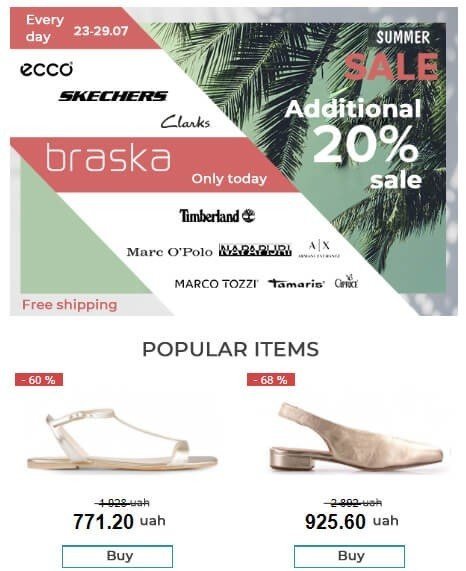
(Source: Email from Prom.ua)
And men's shoes:
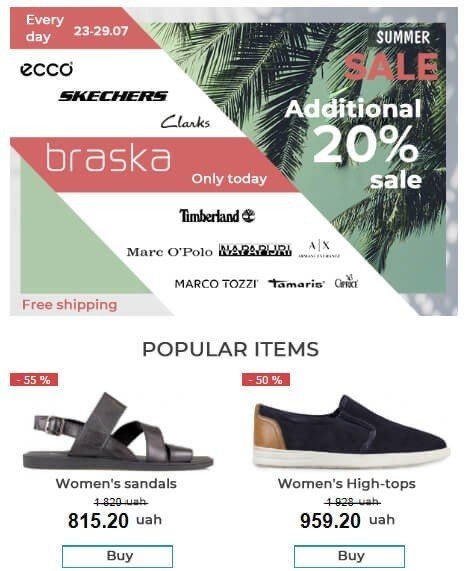
(Source: Email from Prom.ua)
Important to note:
The Stripo Content Display Conditions, which you set manually, enables you to personalize emails by gender, age, geolocation, etc., without the necessity to segment your entire contact base and with no need to build a number of emails. You build one single email, add different product cards for men, women, kids, and those who did not set their gender in your system, set Content Display Conditions, and voila — your users will see emails with relevant products only.
For the manual on how to create and set these conditions, please refer to our blog post “What Makes Stripo an Email Design Platform”, section “Conditions”.
2. Life cycle
The content of your newsletter should depend on the actions of the client. When a potential customer appears for the first time on your site, he or she still does not know anything about you and your product. As for the regular customer, you don’t need to tell him or her how to use your products
Therefore, one of the most popular and effective principles of segmentation depends on the sales funnel stage where the subscriber is located. Let’s take a look at every stage along with email segmentation best practices.
Just registered users
We recommend that you send a welcome email series to new subscribers where you showcase the functionality of the service, describe our services, or present goods.
For example, after registering on the Mango website, its team sends an email to its subscribers asking them to choose the appropriate look:

(Source: Email from Mango)
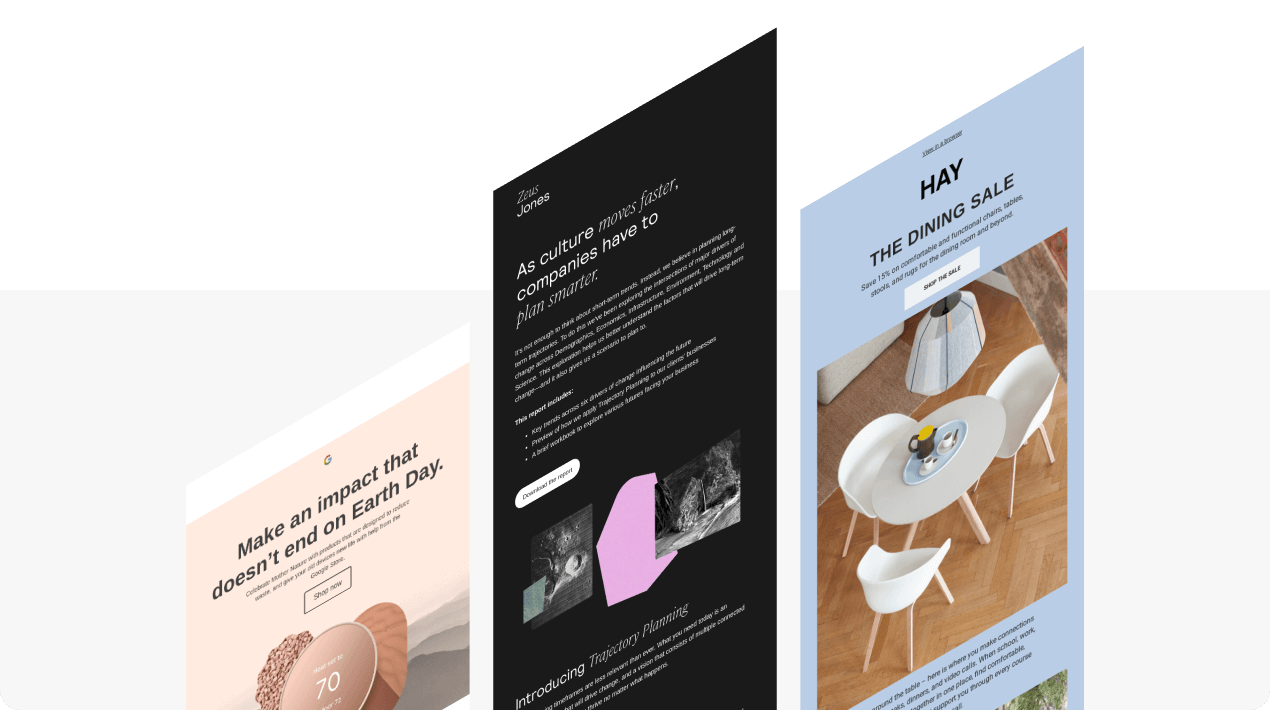
Newbies
They already know about you, but still have not completed any targeted actions. The mailing task for this segment is to show how your product can be useful and what tasks it can solve. Such clients should get a series of fact-finding emails, possibly with a discount offer on their first purchase. Talk about what awaits them in your email, as the team of the vsisvoi.ua online store did.
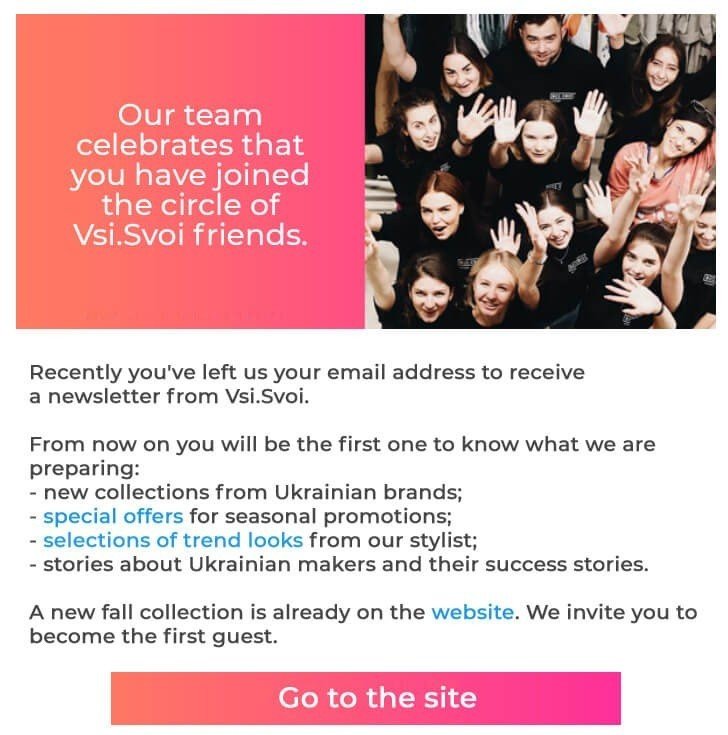
(Source: Email from Vsi.Svoi)
Involved customers
They have already used your product or your services, but not as often nor at the level as you would like. Select them in a separate group and talk about those functions that they might not be aware of yet. Emails with recommendations based on previous purchases can be examples of such newsletters for the B2C sector.

Loyal customers
They regularly use your services, read emails, and thoroughly know your product. Maintain the interest of this group to your product, tell about new products, offer bonuses and ask for their opinion. Airbnb offers $30 to its most loyal users to attract new customers for the next trip:
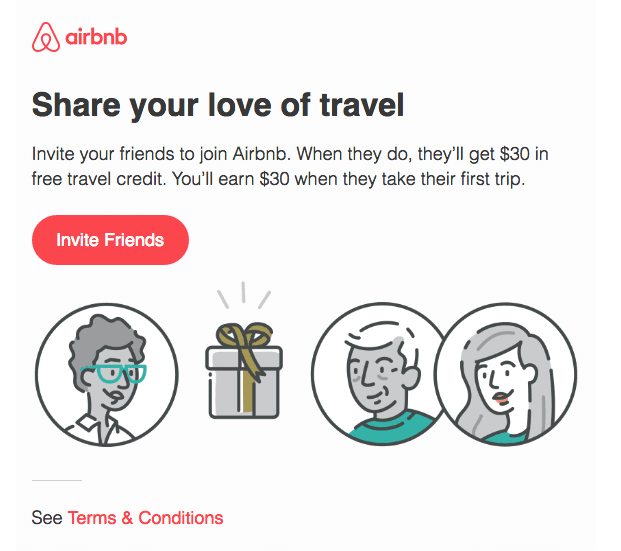
(Source: Email from Airbnb)
Inactive clients
Unfortunately, most customers at some stage cease to use the service or make purchases. The reasons are different; our task is to try to return at least part of your former customers.
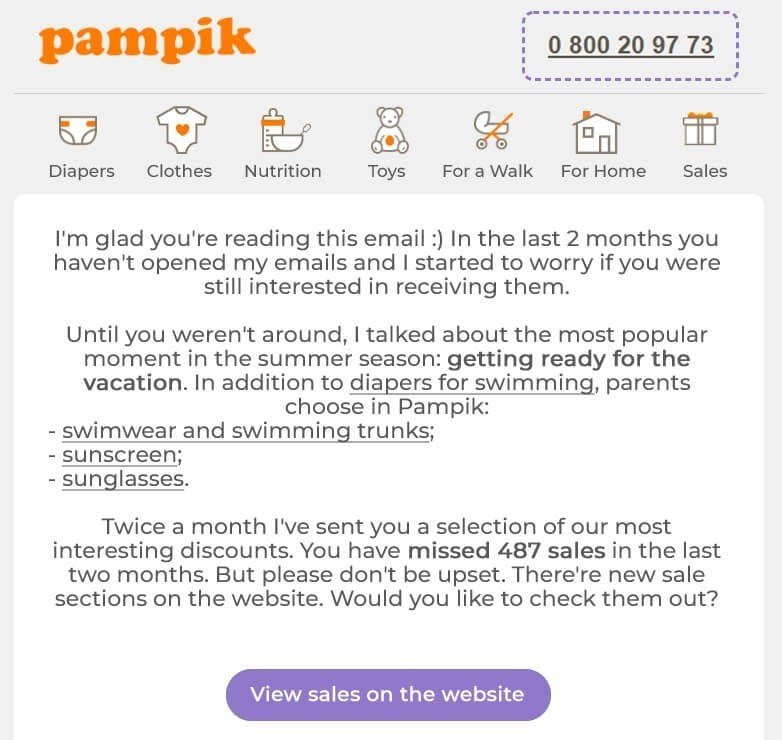
(Source: Email from Pampik)
Remember that the content of your newsletters should be as linked to the customer’s actions as possible.
Please see more examples of great re-engagement email campaigns.
3. Customer behavior
This criterion can be divided into 2 parts: the behavior on the website and the behavior in the received newsletters.
In the newsletters
There are plenty of opportunities for email list segmentation. You can select the following segments:
-
those who opened;
-
those who opened and completed any targeted action;
-
those who opened but did not click any link;
-
those who did not open.
Consequently, the following mailings for each of these segments should be different: additional reminders for those who opened the email and did not take any action; reactivation campaign for those who have stopped reading emails.
On the website
When subscribers visit the website from newsletters, they can also be divided into different segments:
-
went to the site;
-
went to the site and performed the targeted action;
-
went to the site and did not perform the targeted action.
For example, the Citrus.ua online store sends an email with a product that a website visitor was interested in but didn’t purchase:
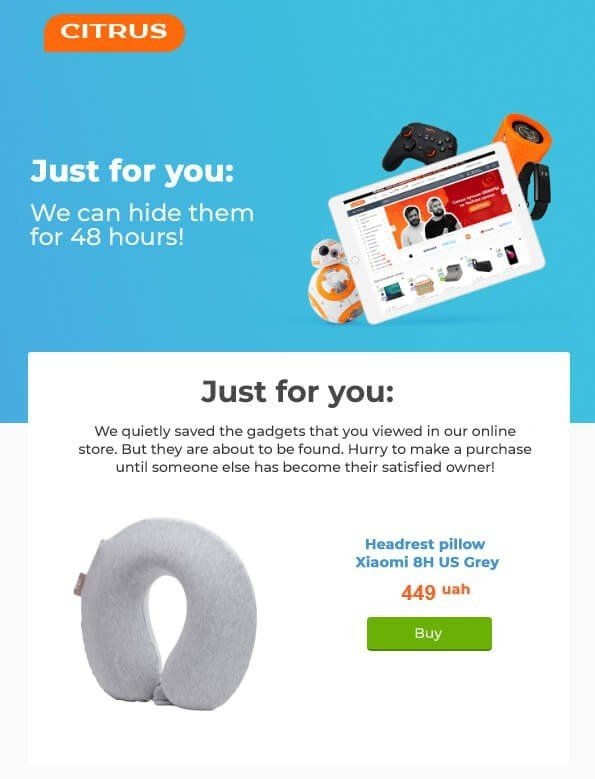
(Source: Email from Citrus)
Since I did not buy anything, I received the following email with a selection of products in the same category:
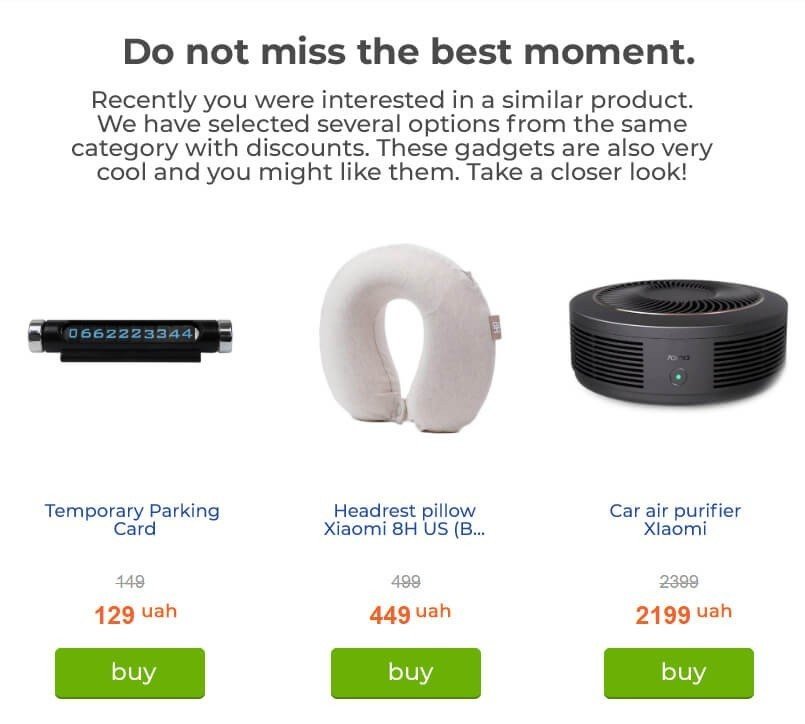
(Source: Email from Citrus)
Track the pages and sections that the client visits, pay attention to the frequency and amount of purchases. It is important that your mailing system allows you to correlate the actions of the client with his email. Based on this data, you can configure trigger mailings (recommendation emails and abandoned carts) and promos. Pay attention to the purchase time, this is a piece of crucial information, for example, for the tourism business. For customers who usually prefer a summer vacation, but have not yet purchased a similar tour, Travelata.ru sends a personalized email. The OR of such newsletters increases by a factor of 1.5.
You can create informational infographics to visualize this data with the help of Infographic Maker and use them in your campaigns to deliver your messaging.
Top-5 benefits of email list segmentation
1. Increased relevance
One of the most significant advantages of email segmentation is that it allows businesses to deliver highly relevant and personalized content to their subscribers. By sending emails to specific segments, you can tailor your messages to address each group's particular needs and interests, which can significantly increase the relevance of your emails.
2. Improved engagement
When you send emails that speak directly to the interests and needs of your subscribers, you are more likely to keep them engaged and interested in your brand.
3. Higher conversion rates
Because segmented emails are more relevant and targeted, they are more likely to convert subscribers into customers. When you send the right message to the right person at the right time, you create a stronger connection with your subscribers, which can lead to increased conversion rates.
4. Better email deliverability
You can also improve your email deliverability rates by sending highly targeted and relevant emails to your subscribers. This is because ESPs are more likely to view your emails as valuable content and not spam, which can help you avoid the spam folder and ensure your content reaches your subscribers' inboxes.
Using email segmentation can help businesses create and send targeted campaigns that resonate with their audience and drive better results from their email marketing efforts. You can increase engagement, drive conversions, and improve customer retention by tailoring your messaging, content, and offers to each segment.
Examples of successful email campaigns that used segmentation
1. Skybound Entertainment — 80% increase in open rates with email personalization and segmentation
According to the data points on Sendlane's website, Skybound Entertainment increased its email open rates by 80% after using Sendlane's marketing automation platform. Skybound Entertainment used Sendlane's features like email personalization, segmentation, and A/B testing to create more engaging and relevant email campaigns.
This significantly increased open rates, which ultimately helped the company achieve its marketing goals.
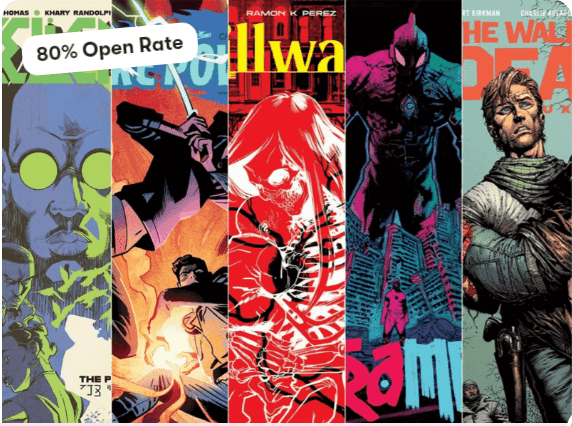
(Source: Sendlane)
2. Klaviyo — 57% increase in email-driven revenue and a 75% increase in email click-through rate
The Klaviyo case study on Taylor Stitch, a clothing company, showcases how email segmentation and personalized content can drive revenue growth.
Using Klaviyo's platform, Taylor Stitch could segment its email list based on customer behavior and purchase history, allowing them to send tailored content that resonated with subscribers. This approach resulted in a 57% increase in email-driven revenue and a 75% increase in email click-through rate.
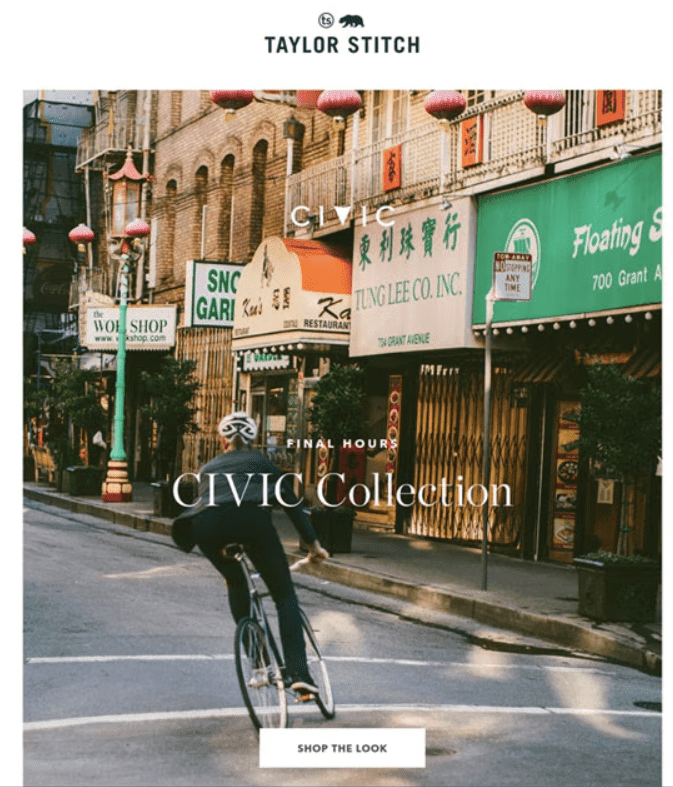
(Source: Klaviyo)
3. Forces Cars Direct — 236% increase in email subscribers and 170% ROI in 4 months
The case study by Pure360 highlights how Forces Cars Direct, a UK-based car dealership, wanted to focus on email marketing to engage existing prospects.
As a result, the company achieved a 236% increase in email subscribers and 170% ROI from a single email campaign in four months. Using targeted messaging and triggered emails, Forces Cars Direct encouraged recipients to complete their enquiry forms and engage with their brand.
Additionally, the campaign was timed strategically to coincide with a holiday weekend, which helped to drive further engagement and revenue.
How to use email list segmentation to boost ROI
1. Define your target audience
The first step in email list segmentation is to define your target audience. Who are you trying to reach? What are their interests, behaviors, and demographics? You can better understand your target audience and create more tailored email marketing campaigns by creating buyer personas.
Let’s consider the Facebook stats using the target audience.
Analysis of Facebook user demographics reveals that a higher percentage of women (75%) use the platform compared to men (63%).
While most users across all age groups use Facebook, recent trends show a decline in teenage usage, with many opting for platforms such as Snapchat, Youtube, and Instagram. Among Facebook users, the highest percentage of users (84%) falls in the 25-30 age group, followed by 79% in the 30-49 age group and 68% in the 50-64 age group.
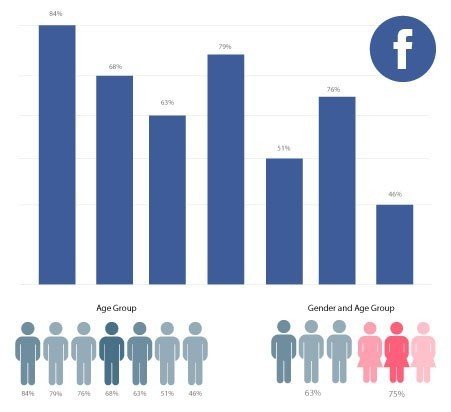
(Source: NotifyVisitors)
In terms of location, Facebook boasts the most extensive user base in India (320 million users), followed by the US (190 million users), Indonesia (140 million users), Brazil (130 million users), and Mexico (93 million users).
Education-wise, the statistics indicate that 74% of people with more than a college education, 75% of those with a college education, and 61% of those with a high school education or less use Facebook.
These audiences have different backgrounds, knowledge, expectations, needs, and preferences, so it’s crucial to tailor your email marketing campaigns to each segment to provide a more personalized experience.
2. Collect and analyze data
After defining your target audience, the next step is to collect and analyze data. You can collect data through website analytics, email marketing software, customer surveys, and other sources. This data will help you identify patterns and insights to strengthen your segmentation strategy.
3. Segment your list
Once you have collected and analyzed your data, it's time to segment your email list. This can be done based on demographics, behavior, interests, and engagement level.
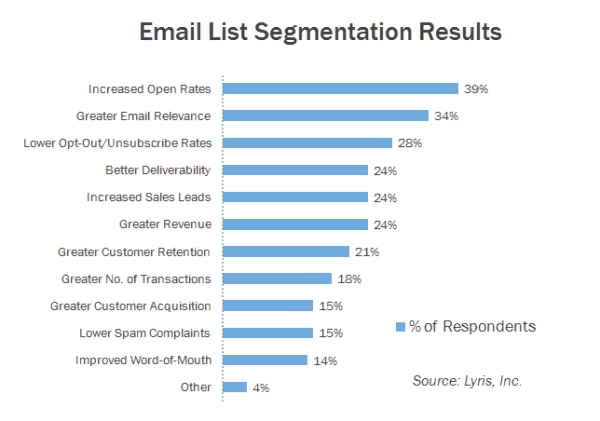
(Source: Email On Acid)
4. Personalize your emails
Personalization is critical to making your email campaigns more effective. By using subscribers' names, locations, and special occasions, you can create a unique experience for each recipient.
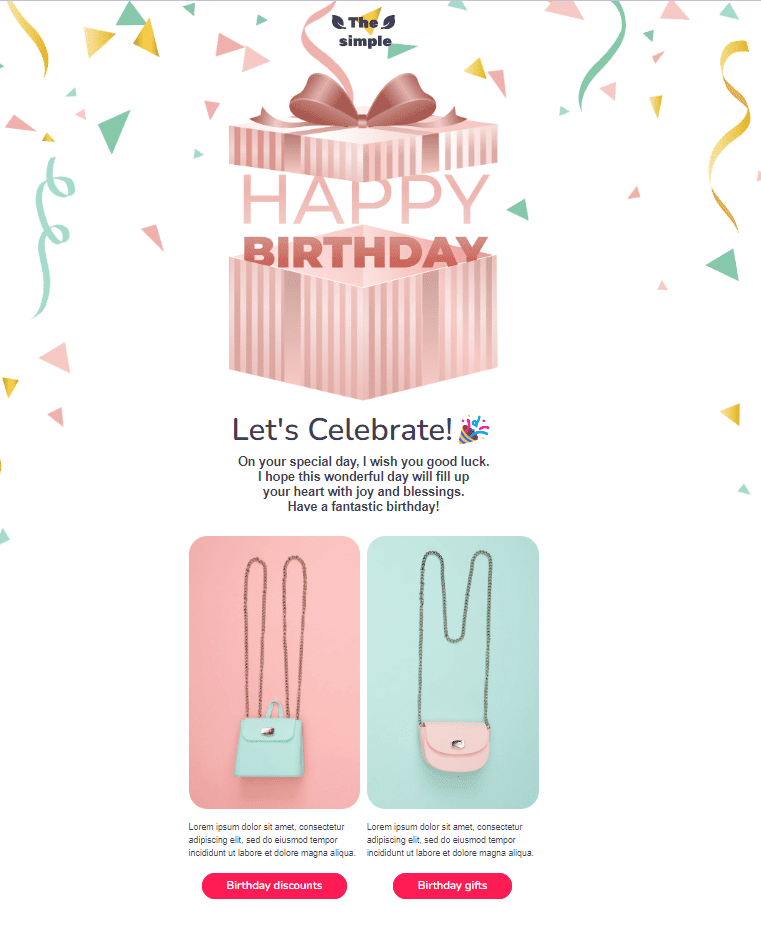
(Source: Stripo template)
According to a study by Experian, personalized emails had an average open rate of 29.3%, while non-personalized and irrelevant emails had an open rate of 22.2%.
5. Test and optimize
To maximize your ROI, testing and optimizing your email campaigns is essential. Use A/B testing to test different subject lines, content, and offers to see which resonates better with each segment. Analyze your data and use it to optimize your campaigns and improve your results over time.
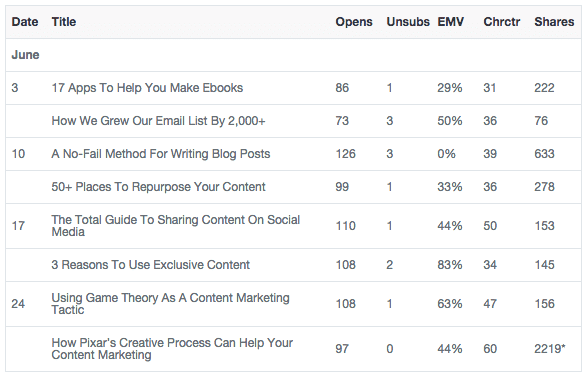
(Source: Zapier)
As in the above example, the A/B testing of an email campaign with a length of 47 characters in a subject line is often referenced as being close to the ideal length of 41 characters.
However, achieving a specific character count is just one aspect of crafting an effective subject line. There are other important elements that contribute to the art of subject line composition. The success of your subject lines can vary depending on various other factors, such as numbers, personalization, descriptive preheader text, humor, emojis, and a sense of urgency.
6. Automate your campaigns
Automation is a powerful email segmentation tool that can save time and resources while improving the effectiveness of your campaigns. Email marketing automation tools are used to send emails based on specific triggers, such as a subscriber's behavior or engagement level. This can help you create a more efficient and effective email marketing strategy that drives a higher ROI.
Automated emails have been shown to generate a substantial increase in open rates compared to non-automated emails, with a boost of 46%. What’s more, the average open rate of automated cart abandonment emails is 29.6%.
the average open rate of automated cart abandonment emails
Moreover, Experian's research highlights that customers who receive automated abandoned shopping cart emails are 2.4 times more likely to complete their purchase. This underscores the importance of incorporating automated email campaigns into marketing strategies.
Finally, Emailmonday reports that 56% of all companies are currently utilizing marketing automation, indicating its growing prevalence and importance in digital marketing.
of companies use marketing automation
You can create a flow chart with all the data and steps you need for your automated email marketing campaign. This will give you a clear understanding of what is required to proceed with your campaign to make it a success.
Wrapping up
Email list segmentation is a powerful tool that can help businesses improve the effectiveness of their email campaigns. By dividing your email list into smaller segments based on shared characteristics or behaviors, you can send targeted and personalized messages that are more likely to resonate with your subscribers.
To successfully implement email segmentation, you need to follow best practices such as defining your segments, collecting and analyzing data, and segmenting your list. This will help you identify the right messages to send to the right people at the right time.
Using email segmentation can also help businesses boost their ROI. You can increase engagement, sales, and revenue by sending personalized content, targeted promotions, and upselling to specific segments.
If you're looking to improve the effectiveness of your email marketing campaigns, email segmentation is a strategy worth considering. Start using email list segmentation today and see the results for yourself.





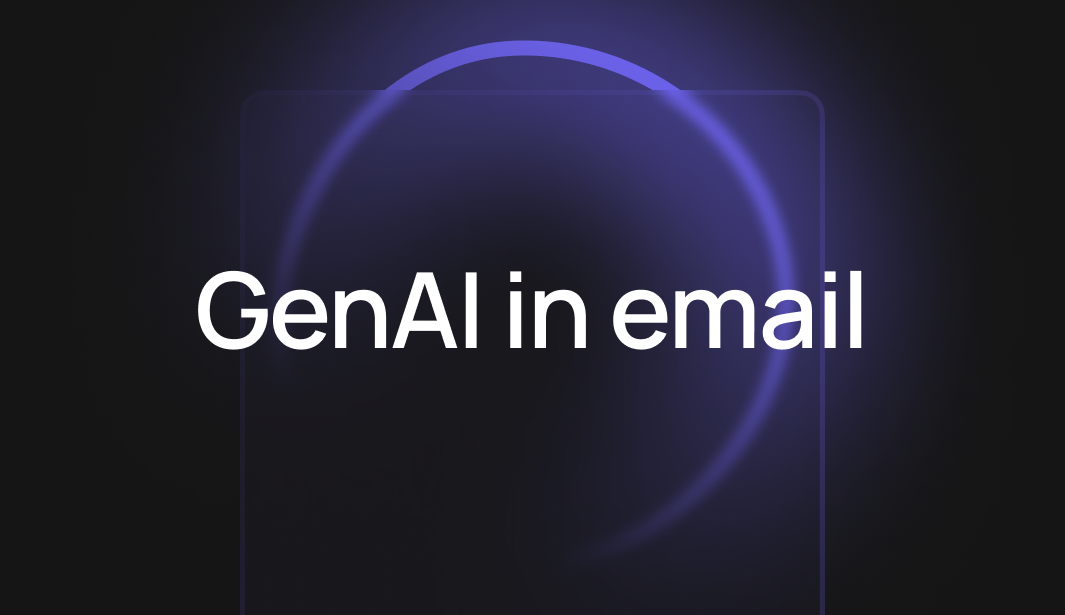
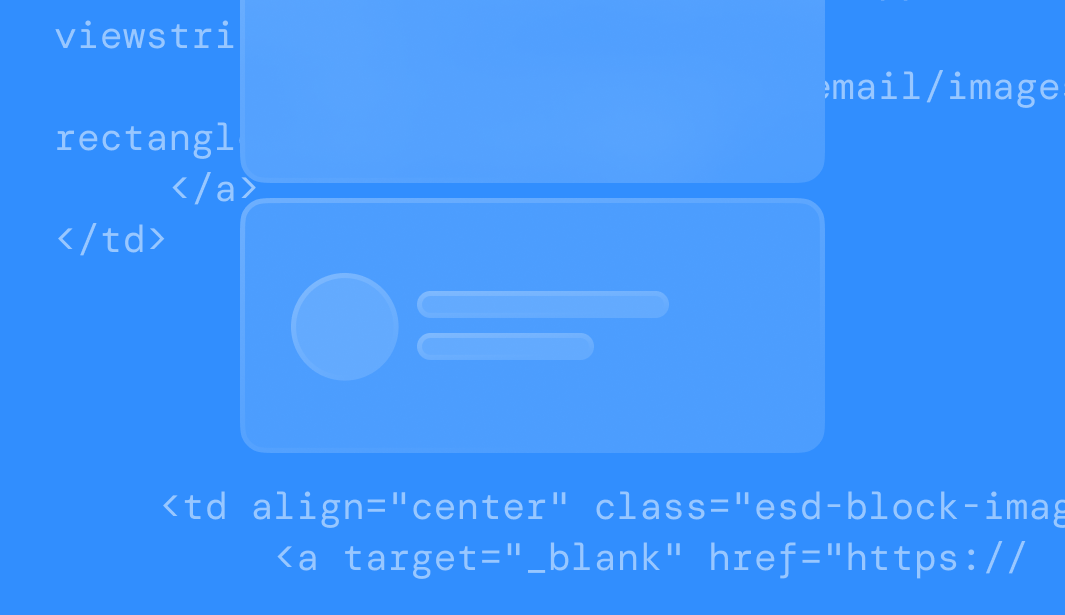

2 comments